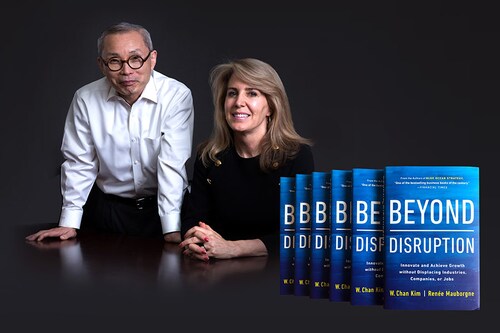It's possible to create the new without destruction or disruption: W Chan Kim an
The professors at Insead unveil the concept of 'non-disruptive creation' in their new book Beyond Disruption


W Chan Kim and Renée Mauborgne are professors of strategy at INSEAD and codirectors of the INSEAD Blue Ocean Strategy Institute in Fontainebleau, France. They are the authors of the global bestsellers Blue Ocean Strategy, Blue Ocean Shift and the recently released Beyond Disruption – Innovate and Achieve Growth without Displacing Industries, Companies of Jobs. In this interview, they introduce us to a new approach to innovation and its distinct advantages to business and society.
Q. What are the defining features of non-disruptive creation’?
At the most basic level, nondisruptive creation can be thought of as the flipside of, and complement to, disruption. While it can be generated by inventive technology, it can also occur with a new combination or application of existing technology. Second, it can be but doesn’t have to be new-to-the-world. And last, is applicable to any geographic area, be that developed markets or bottom-of-the-pyramid markets and across all socioeconomic strata.
Nondisruptive creation is a distinct concept that can universally be defined as the creation of a brand-new market outside or beyond the boundaries of existing industries.
Q. How does it compare with disruptive creation in terms of outcome?
Disruptive and nondisruptive creation complement one another. When industries are ineffective, inefficient, or produce a marked negative side-effect on the environment or people, they become prime targets for disruption. In contrast, nondisruptive creation is advised when that is not the case. Instead of directing you to destroy an existing industry, it directs you to solve brand new problems that no industry currently addresses or create fresh opportunities beyond existing boundaries.
The IPL is a good example. The BCCI saw the possibility of creating a brand-new nondisruptive opportunity beyond classic cricket that all Indians could enjoy in real time without displacing existing Indian leagues or curbing the enthusiasm of purists. With the creation of the IPL, the BCCI created the nondisruptive new market of “cricketainment" and transformed its flat growth line into a steep upward trajectory. Since its first year in 2008, the IPL has received an overwhelming response. As of 2021, it was valued at about $6 billion, with viewership climbing to more than 400 million.
People want to believe that the company they work for not only creates innovative offerings that positively influence lives but, in doing so, does not destroy the lives of others. So by social good here, we mean the unique ability of nondisruptive creation to not only innovate new markets but to do so without causing the social harm of shuttered companies, lost jobs, and hurt communities that occurs when market creation comes with market destruction.
Q. What are the best ways to identify a non-disruptive opportunity?
To begin, be clear that your objective is not to disrupt or compete but to solve a brand-new problem or create and seize a brand new opportunity. At the macro level, you want to think about pressing but overlooked issues in the world, in your industry, in your vocation, or in our lives that you are passionate about and that people or organisations are struggling with—or about burning but unseized opportunities that could, if created, make a real difference.
A brand new problem or opportunity doesn’t necessarily mean that it suddenly popped up. Take Mohammed Yunus, the founder of Grameen Bank. He was passionate about poverty reduction in his country, Bangladesh, where the poorest householders worked under unimaginably tough conditions yet aspired to improve the quality of their lives. Yet these same people were universally deemed not creditworthy. This problem had long existed. The unintended effect was generational poverty, which was seen and treated as an unfortunate part of life’s hard reality—until Yunus set out to address it with a market solution that became the nondisruptive market of microfinance.
Q. Why is a ‘could’ mindset important?
Don’t ask what the business model and technology should be to realise your nondisruptive creation ask what they could be to turn this into a thriving opportunity. Because “should" tends to paralyse our creative imaginations by driving us to find the answer. Also, it acts as a sieve that shuts off options instead of allowing us to think freely. “Could", by contrast, energises us and takes our foot off the pressure pedal. It asks us to think of possibilities, not the answer. Too often we treat our current perception and understanding as though they are permanent and intransigent rather than flexible. When we wake up to that fact, we become willing to alter our thinking, to be open to the thinking of others, and to question what we may have taken as given and true. That allows us to step out of the realm of It can’t be done and into the realm of curiosity, openness, and possibility, where the mechanics of nondisruptive creation are realised.
Take Jim McKelvey and Jack Dorsey, whose company Square (now renamed Block) created the multibillion-dollar nondisruptive new market of credit card readers for micro-businesses and individuals. When McKelvey saw an opportunity to leverage the iPhone to process credit card payments, the only accepted method of connecting any piece of electronic hardware to Apple’s phone was through its proprietary dock connector, which is what you plug your charger cable into. And to use the dock connector, you had to follow Apple’s technical specifications, go through a lengthy approval process, and pay royalties. But “should" didn’t interest Jim. He thought in terms of ‘could’ and instead used the universal phone jack to create a reader that worked with any type of phone with no need for Apple’s approval nor the need to pay royalties. It was the first company in the world to circumvent Apple’s dock connector.
First Published: Oct 25, 2023, 11:24
Subscribe Now